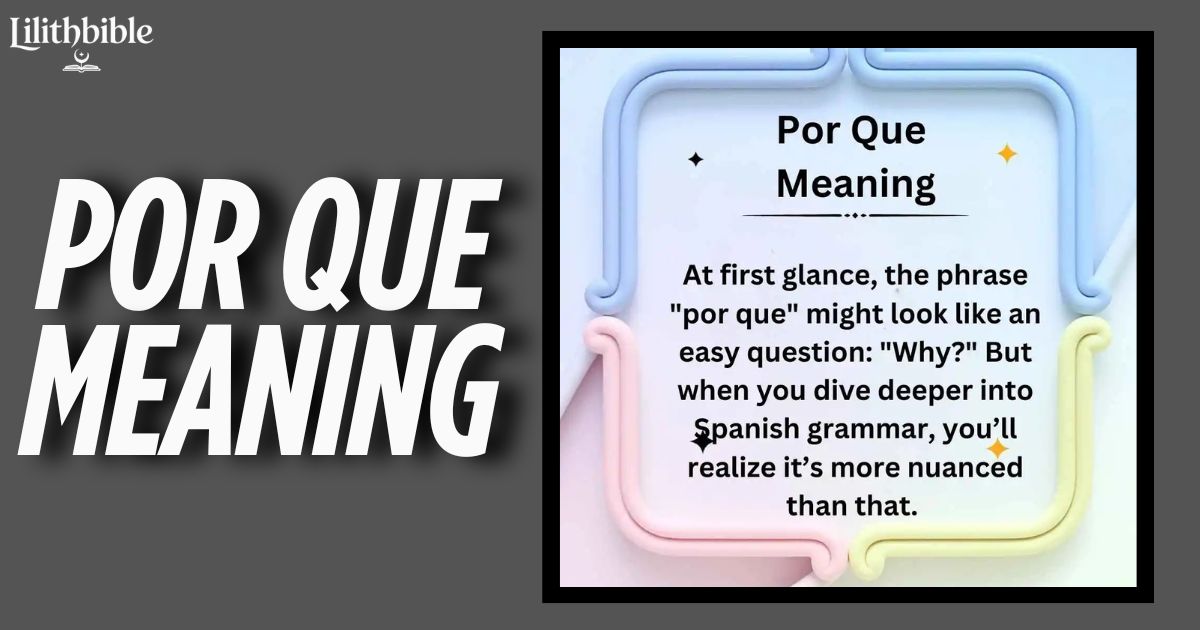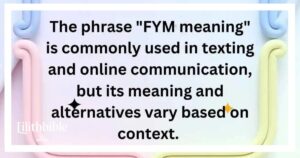Por Que Meaning often leaves Spanish learners scratching their heads. It looks like a single word, but it’s actually two and that changes everything! So, what does por que mean exactly? In Spanish, “por” translates to “for” or “because of,” while “que” means “what” or “that.” Together, por que meaning Spanish shifts based on context. It can ask “why” in a question or introduce an explanation.
Some learners even mishear it as porkay meaning, but that’s just an English attempt at its pronunciation. Understanding por que is key to forming proper Spanish sentences. Whether in everyday conversations or formal writing, this phrase pops up everywhere. Mastering por que meaning improves fluency, making Spanish communication effortless. Don’t let confusion hold you back! Keep practicing and soon, you’ll use por que meaning Spanish like a pro!
What Does “Por Que” Mean?
Understanding Por Que Meaning is essential for Spanish learners. It can mean “why” in a question or introduce an explanation. Knowing when to use it correctly improves fluency and confidence.
Common Uses of “Por Que”
- “Por que” appears when you’re using the subjunctive mood or in certain formal contexts.
- It helps form direct and indirect questions in Spanish grammar.
- You’ll see “por que” in complex sentences with conjunctions and explanations.
- It often appears in Spanish writing, especially in structured arguments.
- Many Spanish students confuse it with “porque,” which means “because.”
Mastering “por que” makes Spanish communication easier. With practice, you’ll use it naturally in conversations and writing!
The Different Forms of “Por Que”
Por Que Meaning changes based on its form. “Por qué” asks “why” in a question, while “porque” means “because.” “Por que” and “porqué” have different uses too. Understanding these variations helps in Spanish grammar and conversation. Learning them improves fluency and makes communication easier.
“Por Que” (Two Separate Words)
“Por que” appears when “por” and “que” happen to be next to each other. It often follows verbs like “luchar” or “abogar.” This form is less common but still important in Spanish writing. Knowing when to use it helps avoid mistakes.
- Example sentence: Luchamos por que haya justicia.
- Example sentence: No entiendo por que lo hiciste.
Mastering these differences makes learning Spanish smoother. Keep practicing, and soon, these phrases will feel natural!
When to Use It
- You’ll find it in questions like “por qué llegaste tarde?” (Why did you arrive late?).
- Writers use it in explanations such as “te lo digo porque te quiero” (I tell you because I love you).
- It helps in expressions like “no entiendo por qué pasó” (I don’t understand why it happened).
- Spanish speakers use it in indirect speech like “me preguntó por qué me fui” (He asked me why I left).
- You’ll see it in literature, as in “buscamos razones por que luchar” (We seek reasons for which to fight).
“Por Qué” (With an Accent on “Qué”)
Por Que Meaning changes when written as “por qué.” This form is used in direct and indirect questions. It always asks “why” in Spanish. Understanding “por qué” helps with proper sentence structure. Learning its correct placement improves fluency and avoids confusion in Spanish writing and conversations.
- Example sentence: ¿Por qué no viniste ayer?
When to Use It
- “Por qué” is used only when asking a question, either directly or indirectly.
- You’ll find “por qué” in everyday questions like “¿Por qué estás triste?” (Why are you sad?).
- It appears in reported speech, such as “Me preguntó por qué llegué tarde” (He asked me why I arrived late).
- Writers use “por qué” in rhetorical questions, like “¿Por qué me pasa esto?” (Why does this happen to me?).
- In Spanish grammar, “por qué” always needs the accent when asking “why.”
“Porque” (No Accent)
Porque connects cause and effect. It means “because” and answers “por qué” questions. Understanding Por Que Meaning helps learners use “porque” correctly. It often appears in explanations. Mastering it improves Spanish fluency and grammar.
- Example sentence: Ella estudia porque quiere aprender más.
(She studies because she wants to learn more.)
When to Use It
- Use “porque” when answering a “por qué” question.
- Use “porque” in everyday speech and writing.
- Use “porque” to link actions and reasons.
- Use “porque” to sound natural in Spanish conversations.
“Porqué” (One Word, With an Accent)
Por Que Meaning changes when written as “porqué.” It acts as a noun meaning “the reason.” You’ll often see it with articles like “el” or “un.” Understanding its role in sentences makes Spanish grammar easier. Using it correctly helps avoid common mistakes in writing and conversation.
- Example sentence: Nunca entendí el porqué de su partida.
(I never understood the reason for his departure.)
When to Use It
- You’ll often see “porqué” with definite articles like “el” or “un” in sentences.
- Writers use “porqué” in explanations to clarify the cause of something.
- It helps express reasons in formal writing and structured arguments.
- Understanding “porqué” avoids confusion in Spanish grammar and sentence structure.
Common Mistakes Learners Make with “Por Que”

Many Spanish learners confuse the different forms of por que meaning. Each one has a unique meaning and usage. Misusing them can lead to misunderstandings in conversations and writing. It’s important to learn the correct structure for questions, explanations, and reasons. By avoiding these common mistakes, you can improve your Spanish grammar and communication skills.
Mistake #1: Writing “porqué” instead of “por qué” in a question.
Correct usage: “Por qué” is two words and always used in direct and indirect questions.
Mistake #2: Forgetting the accent in “por qué” when asking why.
Correct usage: The accent is necessary to differentiate it from other forms.
Mistake #3: Using “por que” when “porque” is needed for answers.
Correct usage: “Porque” explains reasons, while “por que” is rarely used alone.
Mistake #4: Assuming “porqué” and “porque” mean the same thing.
Correct usage: “Porqué” is a noun meaning “the reason,” while “porque” means “because.”
Mistake #5: Mixing “porqué” with “el porque” in explanations.
Correct usage: “El porqué” is correct when referring to “the reason for something.”
Mistake #6: Translating English “why” as “porque” instead of “por qué.”
Correct usage: “Why” in Spanish is always “por qué” with an accent.
When and How to Use “Por Que” in Everyday Conversations
“Por que” is commonly used in Spanish conversations to introduce explanations or clarify reasons. It often follows verbs like “preguntar” (to ask) when explaining why something happens. In casual speech, it helps connect thoughts smoothly. Whether asking for reasons or providing them, using “por que” correctly makes conversations more natural and fluent. Mastering it improves both understanding and speaking skills in Spanish.
Asking Questions
“Por qué” is used in Spanish to ask why something happens. It appears in both direct and indirect questions. This phrase helps gather information and understand reasons behind actions. Learning how to use it correctly makes Spanish conversations clearer and more natural.
- Example sentence: ¿Por qué llegaste tarde?
(Why did you arrive late?)
Understanding “por qué” improves communication. It allows you to ask meaningful questions in conversations. Mastering it helps you sound more fluent and confident in Spanish.
Expressing Doubts or Uncertainty
“Por que” is often used when questioning reasons or expressing uncertainty. It appears in indirect questions or when someone doubts a situation. This phrase helps convey hesitation or confusion in conversations.
- Example sentence: No estoy seguro por que cancelaron el evento.
(I’m not sure why they canceled the event.)
Using “por que” correctly allows speakers to express doubts clearly. It’s essential for understanding and forming complex questions in Spanish.
Differences Between “Por Que” and Other Related Spanish Phrases
“Por qué” with an accent asks direct questions, while “porque” (one word) means “because.” “Porqué” (with an accent) is a noun meaning “the reason.” Meanwhile, “por que” (two words) is used in specific grammatical structures. Understanding these differences helps in mastering Spanish sentence structure and communication.
“Para Qué” vs. “Por Qué”
- “Por qué” asks about reasons, while “para qué” focuses on the end goal.
Example: ¿Por qué estudias español? vs. ¿Para qué estudias español?
(Why do you study Spanish? vs. What’s the purpose of studying Spanish?) - Use “para qué” when asking about an objective rather than a cause.
Example: ¿Para qué compraste tantos libros?
(What’s the purpose of buying so many books?) - “Por qué” is often used to ask why something happened, while “para qué” looks ahead.
Example: ¿Para qué viniste tan temprano?
(For what purpose did you come so early?) - “Para qué” is common when discussing plans or intentions.
Example: ¿Para qué vamos a la reunión?
(What’s the purpose of going to the meeting?) - In many cases, “para qué” implies a desired outcome rather than a cause.
Example: ¿Para qué quieres aprender a cocinar?
(What’s your goal in learning to cook?) - Use “por qué” for past explanations and “para qué” for future intentions.
Example: ¿Para qué entrenas todos los días?
(What’s your goal in training every day?) - “Para qué” often appears in questions about necessity or usefulness.
Example: ¿Para qué sirve este botón?
(What is this button used for?)
“Por Qué” vs. “Por Qué Razón”
“Por qué” asks “why” in general, while “por qué razón” means “for what reason” and sounds more formal. The second phrase is often used in serious discussions or writing.
Example sentence: ¿Por qué razón llegaste tarde?
(For what reason did you arrive late?)
Both phrases are useful, but “por qué razón” adds emphasis. Knowing when to use them helps in both casual and formal conversations.
Key Tips to Mastering “Por Que” and Avoiding Confusion
Mastering these Spanish phrases takes practice. Each form has a unique use, so understanding them is key. Read examples, listen to native speakers, and practice writing sentences. The more you use them, the more natural they become. Learning small grammar tricks will help you avoid mistakes and improve your Spanish fluency.
- Practice with examples: Write sentences using each form to understand their differences better.
- Listen to native speakers: Pay attention to how they use these phrases in conversations.
- Read Spanish texts: Observe how writers use different forms in books and articles.
- Test yourself: Quiz yourself regularly to reinforce your understanding.
- Use flashcards: Create cards with sentences to help memorize correct usage.
- Think about meaning: Always consider the context before choosing a form.
- Ask for feedback: Have native speakers check your sentences for mistakes.
- Break down sentences: Analyze examples to see why a certain form is used.
- Keep practicing: The more you use these phrases, the more confident you’ll become!
FAQ’s
What does it mean in Spanish?
Por Que Meaning depends on the sentence. It can mean “why” in a question or introduce an explanation, making it essential in Spanish grammar.
How do you use it correctly?
Understanding Por Que Meaning helps in Spanish conversation. Use “por qué” for questions and “porque” for answers to communicate clearly and naturally.
Why do people mispronounce it?
Many learners hear Por Que Meaning as porkay meaning because of its pronunciation. It’s important to learn the correct spelling and usage in Spanish.
Is it the same as porque?
No, Por Que Meaning is different from “porque.” “Por qué” asks “why,” while “porque” means “because.” Learning the difference improves Spanish fluency.
How can I remember its meaning?
To master Por Que Meaning, practice reading and writing Spanish questions. Understanding context will make it easier to use correctly in conversations.
Conclusion
Mastering Por Que Meaning is key to understanding Spanish. It may seem tricky at first, but practice makes it easier. So, what does por que mean? It depends on context. Sometimes, it asks “why,” while other times, it explains something. Learning Por Que Meaning Spanish helps in conversations, writing, and grammar. Many learners confuse it with porkay meaning, but that’s just a mispronunciation.
Using por que correctly makes you sound more natural in Spanish. Whether in formal writing or everyday speech, it appears often. Knowing Por Que Meaning improves fluency and confidence. Keep practicing, and soon, you’ll use por que without hesitation. Spanish grammar may have its challenges, but with effort, you’ll master it. Understanding Por Que Meaning Spanish will make learning the language smoother. So, don’t stop practicing. The more you use por que, the more natural it becomes!

Dayo Olu is the experienced admin of LilithBible, a blogging website. With 5 years of strong blogging and content management experience, Dayo supports the platform from Nigeria with great care and dedication.








